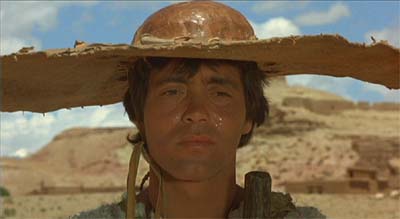The ancient Greek myth of Oedipus is a familiar one. Oedipus, the king's son, is abandoned as a baby and left to die in the wilderness because of a prophecy that he will kill and replace the king. He is rescued by a shepherd. Later in life, he kills the king (not knowing that he is the king, and his original father) in an argument over right of way, and then goes on to solve the riddle of the tyrannical Sphinx and to marry the queen (who doesn't know Oedipus is her son, nor the murderer of the king). In the fullness of time he finds out what he has done - killed his father the king and married the his mother, the queen. This shocking revelation causes Oedipus to put out his own eyes, and return to the wilderness in repentance and shame.
Here's a clip of Pasolini's treatment of the story:
There's a good article on Senses of Cinema website about Pasolini here.





”Oedipus Rex” (1967) – Knowledge without Explanation Is Directed Against Those Who Need It the Most Authoritarian Truths of the Fathers and Gods As Patriarchal Weapon to Keep the New Generations Under Control “Oedipus Rex” examines the relationships between the young generations and systems of power at various periods of Western history. Taking the tragedy by Sophocles as a semantic skeleton of his film, Pasolini adds to the Greek play historical perspective – he assembles the scenes that took place in Ancient Greece, life during fascist period in Italy, and what happens to Oedipus during the post-WW2 Italian “economic miracle”. Pasolini emphasizes the historical universality of Oedipus’ predicaments. By doing this incredible semantic/stylistic equilibristic, Pasolini returns science-fictional paradigm of time-travel from being part of the content of art to where it belongs – to its form. From the epoch of Italian fascism the hero is “transferred” by the director to Ancient Greece and from there to Italian democratic post-modernity. Pasolini dedicates the film to the analysis of how the youth in different epochs relates to the truth about societal life (how much or how little young people are able to understand how the system functions and how they are mistreated at the hands of the elder generations), and with what tricks and tactics the systems of domination make it impossible for the young to understand what life is really about. Through particular images and twists of the plot Pasolini enumerates five strategies of distorting truth by the system which makes it impossible for the youth to reach rational understanding of the social reality. Truth without explanation and prediction without validation – the dogmatic (authoritarian) truths of the ancient oracles and prophets and today’s conservative propagandists alike explain reality through the expecting/forecasting crimes of victims of socio-political system, not through the crimes of those who rule over life. Oedipus is transformed into a criminal not only because he was abused by the hate of his father and not protected against this hate by his mother but also because how his predicaments were formulated by the system. According to Pasolini, condemnation of Oedipus by gods/destiny is the equivalent of being sacrificed by the system that understands crime as a personal transgression of Laws and taboos – not as internalization of system’s values of rivalry, competition, fight, greed, megalomania and belligerency. Pasolini operates with different types of images depicting human reactions – for example, images registering human reaction as that of people’s psychological wholeness, not just reaction on the circumstances, or images with symbolic connotations making them archetypal, like that of Oedipus biting the back of his hand (his palm-his destiny) when he feels trapped in it. Pasolini has a unique ability to root ideas in stylistic configurations and effects. “Oedipus Rex” is stylistically and intellectually like a unique organism – there is no other film in the history of cinema (including Pasolini’s other ones) like this. Victor Enyutin
ReplyDelete